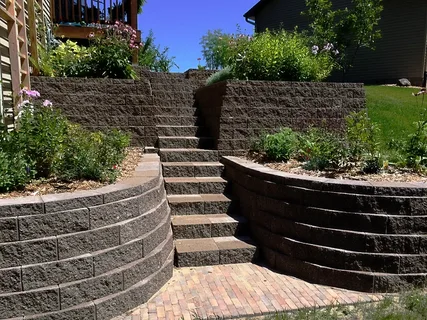Regarding construction projects requiring stability and durability, engineered retaining walls are a popular choice. These walls are designed to support and prevent erosion, making them essential for residential and commercial developments. If you are looking for a reliable solution built to last, engineered retaining walls Brisbane are the way to go.
Understanding the Basics of Engineered Retaining Walls
Engineered retaining walls are specialised structures that counteract the lateral pressure of soil when the terrain’s elevation alters. Their primary purpose is to hold back soil, helping to halt erosion whilst simultaneously transforming slopes into functional spaces. Constructed from concrete, steel, or timber, these walls are meticulously designed to cater to the project’s distinct requirements.
The design considers the soil characteristics, the expected loads, and environmental factors to ensure the wall’s longevity and functionality. By incorporating these considerations, engineered retaining walls offer a robust solution that addresses a construction project’s practical and aesthetic needs.
Key Design Principles for Strength and Stability
The foundation of engineered retaining walls lies in a trio of design principles: ensuring the walls can withstand the lateral pressure from soil, incorporating effective drainage systems, and implementing the right reinforcement and anchoring techniques. These principles are critical in guaranteeing the long-term strength and stability of the structure.
Firstly, understanding the soil mechanics and pressures involved is essential. The design must account for the types of soil and the different pressures they exert, which can vary significantly based on moisture content, type of soil, and depth.
Secondly, adequate drainage is paramount to prevent water accumulation behind the wall, which can lead to increased pressure and potential failure. Strategies such as installing weep holes, drainage tiles, or gravel backfill ensure water is effectively redirected away from the wall, thereby reducing the risk of hydrostatic pressure build-up.
Lastly, the choice of materials and the method of reinforcement play a crucial role. Materials must be selected based on their durability, strength, and suitability for the site’s specific environmental conditions. Reinforcement, whether through steel bars, geotextiles, or anchored systems, is designed to fortify the wall against the forces it will face, ensuring it remains stable and secure over time.
By adhering to these key design principles, engineered retaining walls achieve a balance of functional excellence and aesthetic appeal, making them a reliable choice for managing landscapes and supporting structures.
Benefits of Using Engineered Retaining Walls in Construction
The advantages of incorporating engineered retaining walls into construction ventures are manifold. Notably, these structures play a crucial role in providing robust structural support, effectively mitigating the risk of soil erosion. This aspect is particularly beneficial in areas prone to heavy rainfall or where land slippage could pose a significant risk. Additionally, the implementation of engineered retaining walls carves out additional usable space from previously sloping or uneven terrain. This transformation unlocks new possibilities for landscape design and utility in residential gardens or commercial outdoor areas.
A further merit lies in their aesthetic versatility. Engineered retaining walls can be tailored to blend seamlessly with or enhance the surrounding environment, making them an attractive feature in their own right. From a practical standpoint, their durability and low maintenance requirements stand out. Designed to resist the elements and the test of time, these walls minimise the need for ongoing upkeep, representing a cost-efficient choice in the long term.
Their adaptability extends to various project types and scales, demonstrating their suitability across diverse applications. Whether part of a small residential project or a large-scale commercial development, engineered retaining walls offer a dependable, attractive solution to managing and sculpting the landscape.
Applications in Residential Projects
In domestic development, the engineered retaining walls serve diverse purposes, enriching homeowners’ outdoor living experience. These structures are adept at transforming sloping gardens into terraced havens, enabling the cultivation of diverse plant life and facilitating leisure activities in areas that would otherwise be underutilised due to uneven topography. Moreover, they are instrumental in delineating clear boundaries within the property, such as segregating a patio or children’s play area from the rest of the garden, thereby enhancing safety and privacy.
Engineered retaining walls also offer an aesthetic uplift to the landscape, with an array of design options available to harmonise with or accentuate the architectural style of the residence. From rustic stone finishes to sleek, modern concrete, there is a plethora of materials and finishes that can be tailored to the homeowner’s preferences, ensuring the wall is functional and visually appealing. These walls also play a critical role in soil erosion prevention, protecting the garden and structural foundations from damage caused by runoff and land slippage.
In summary, engineered retaining walls present a versatile and effective solution for overcoming the challenges of uneven terrain in residential settings. They simultaneously offer structural support, aesthetic enhancement, and increased usability of outdoor spaces.
Applications in Commercial Projects
Engineered retaining walls have found their place at the heart of diverse commercial undertakings, showcasing their utility beyond mere structural necessities. They are pivotal in facilitating the efficient use of land within urban environments, especially in areas where space is at a premium.
For instance, by enabling the construction of tiered car parks, these walls significantly enhance the capacity of commercial car parks, a space-efficient and cost-effective solution. Similarly, engineered retaining walls on sloping sites provide the necessary support for buildings, ensuring safety and stability while optimising the available land area.
Moreover, their role extends to the infrastructure sector, where they are integral to constructing and maintaining roads and bridges, contributing to the integrity and longevity of these essential structures. The versatility of engineered retaining walls is also evident in their application as aesthetic and functional elements within commercial spaces. They can be creatively integrated into landscape designs, forming attractive terraces, outdoor seating areas, or planters that contribute positively to commercial properties’ visual and environmental quality.
This multifaceted application in commercial projects underscores engineered retaining walls’ adaptability and value. They serve not only as indispensable structural components but also as elements that enhance the functionality and aesthetic appeal of commercial developments.
Choosing the Right Retaining Wall Specialists Brisbane
Selecting the appropriate retaining wall specialists Brisbane requires careful consideration to ensure the success of your construction project. Begin by researching local companies with specific expertise in engineered retaining walls. Look for specialists who showcase a robust portfolio of residential and commercial projects, demonstrating their versatility and skill in various settings. Reading through client testimonials and reviews can provide insight into the company’s reliability, quality of work, and customer service. Additionally, verifying certifications and insurance is crucial to ensure that the specialist operates within industry standards and is prepared for eventualities.
Feel free to request detailed proposals from several providers, allowing you to compare their approaches, the recommended materials, and the overall cost. A trustworthy specialist will also offer a comprehensive consultation, assessing your needs and the site’s requirements before proposing a tailored solution. Remember, investing time in choosing the right specialist is pivotal in achieving a retaining wall that not only meets your functional needs but also enhances the aesthetic appeal of your property.
The Installation Process: What to Expect
Embarking on the installation of engineered retaining walls commences with meticulous site preparation, where the area is cleared and levelled, setting the stage for the subsequent phases. This is followed by the crucial excavation step, tailored to the predetermined dimensions of the wall, ensuring a solid foundation for the construction. The foundation laying is a precise operation critical for the wall’s integrity, where materials such as concrete are often deployed to form a sturdy base.
Upon completion of the foundation, the assembly of the wall components begins. This phase varies significantly depending on the chosen materials—concrete blocks, steel, or timber. Each element is methodically placed and secured, adhering to the engineering plans that account for the site’s structural demands and environmental considerations.
Backfilling is the final step in the process, involving placing suitable materials behind the wall to promote effective drainage and reduce lateral pressure. This stage is instrumental in extending the lifespan of the wall by minimising the risk of water build-up and soil pressure.
Throughout each stage, a collaborative effort from a team of seasoned professionals ensures the process is executed efficiently, with attention to detail and adherence to safety standards. Engaging with a reputable team guarantees the seamless progression of these steps, culminating in installing an engineered retaining wall tailored to meet the specific demands of your project.
Cost Considerations and Budgeting for Your Project
Budgeting for engineered retaining walls necessitates a comprehensive understanding of all financial aspects involved in the project. It’s imperative to account for the wide-ranging factors that influence the overall cost, including the selection of materials, which can significantly vary in price. Concrete, steel, and timber have distinct price points and longevity, impacting initial outlay and future maintenance. Labour costs also play a crucial role, with complex designs and difficult terrain potentially requiring more specialised skills and, consequently, higher expenditure.
Additionally, unexpected challenges, such as dealing with underground utilities or adverse soil conditions, may necessitate budget adjustments. Engaging a professional for a detailed consultation ensures a thorough evaluation of the site-specific requirements, leading to an accurate estimate. This proactive approach helps mitigate unforeseen expenses, allowing for more precise financial planning.
Prioritising a dialogue with a reputable specialist clarifies the cost implications and aids in exploring cost-effective solutions without compromising the integrity or aesthetic value of the engineered retaining wall.
Conclusion
Engineered retaining walls represent a fundamental solution for enhancing residential and commercial landscapes’ structural integrity and aesthetic value. Their bespoke design enables adaptation to varied project needs, ensuring longevity and resilience against environmental challenges. Engaging with seasoned professionals is crucial in navigating the complexities of construction and achieving an outcome that marries functionality with visual appeal. These walls safeguard against erosion, facilitate the effective utilisation of space, and contribute to the overall landscape design, reflecting a thoughtful integration of form and function. The choice of materials, coupled with expert design and installation, plays a pivotal role in successfully implementing these structures.
FAQs
What materials are best for engineered retaining walls?
The choice depends on your project’s specific needs and environmental conditions. Concrete, steel, and timber are commonly used, each offering distinct advantages in durability and aesthetics.
How long do engineered retaining walls last?
These walls can last several decades with proper design, installation, and maintenance. The lifespan varies based on the materials used and environmental factors.
Can engineered retaining walls be customised?
Absolutely. These walls can be tailored to materials, finishes, and designs to complement or enhance the surrounding landscape.
Are permits required to construct an engineered retaining wall?
Yes, in most cases. The need for permits depends on the wall’s height, location, and local regulations. Consulting with a professional will help determine the requirements for your specific project.
What is the significance of drainage in retaining wall design?
Effective drainage is crucial to prevent water build-up behind the wall, leading to hydrostatic pressure and compromising the wall’s stability.
How can I find a reputable specialist for my retaining wall project?
Research local companies with experience in engineered retaining walls, check their portfolios, read client reviews, and verify their certifications and insurance to ensure their reliability and expertise.

